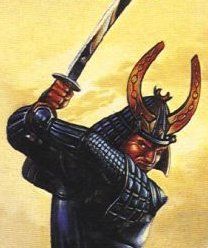 Jon Peterson at Playing at the World has posted Bruce Sterling’s homebrew samurai class from 1978. It’s quite good, actually. The restrictions of the Samurai Code will force the player character to commit seppuku if he’s wounded and retreats without returning a wound to his opponent. The class’s special abilities are doled out in a similar schedule as a magic-user’s spells, anticipating to some extent the feat trees of later editions. And Sterling was as much concerned with addressing game design issues as he is in capturing the flavor of Far East warriors. For example, the immunity to Sleep spells available at level one notably addresses the most prominent “I win button” available to low level parties. Similarly, the bonuses to resisting Charm spells available starting at the third level provides some protection at the second most common “instant win” ability of classic D&D.
Jon Peterson at Playing at the World has posted Bruce Sterling’s homebrew samurai class from 1978. It’s quite good, actually. The restrictions of the Samurai Code will force the player character to commit seppuku if he’s wounded and retreats without returning a wound to his opponent. The class’s special abilities are doled out in a similar schedule as a magic-user’s spells, anticipating to some extent the feat trees of later editions. And Sterling was as much concerned with addressing game design issues as he is in capturing the flavor of Far East warriors. For example, the immunity to Sleep spells available at level one notably addresses the most prominent “I win button” available to low level parties. Similarly, the bonuses to resisting Charm spells available starting at the third level provides some protection at the second most common “instant win” ability of classic D&D.
Though samurai characters are relatively uncommon in Appendix N fiction, Sterling was far from being the only person at the time to put them in gaming terms:
By the time Bruce Sterling incorporated Samurai into his campaign, around 1977, there were thus already precedents to draw upon, but Summers tells us that Sterling’s are “by far the best” rules available at the time. Efforts didn’t stop there: in fact, that year an entire Japanese-themed role-playing game entered the market: Tyr’s Bushido (later reprinted by Fantasy Games Unlimited). No less an authority than Dave Arneson was approached by the Chaosium to write a game called Samurai in 1978, though sadly the project never came to fruition. TSR revisited the Samurai class in The Dragon #49 (as an overpowered non-player character only) and then most famously in Oriental Adventures (1985)
Meanwhile, over at Gaming Ballistic, Douglas Cole has a post on working up samurai characters in the latest edition of D&D. Judging by his write-up, the system is enough of a tool-kit that it can be done pretty well out of the box. Doug notes that in his take on it, he fully embraces whatever mistakes James Clavell might have made in Shogun. While that sort of thing is liable to irk historians and nit-pickers, I think playing to peoples’ false impressions is actually a good idea in tabletop role-playing. (Keeping things moving and helping players connect with the actual gameplay is the key thing there, after all….)
Probably the most striking thing about the AD&D Samurai from Oriental Adventures when compared to both of these adaptions is that a lot of effort was spent working how many bushi, samurai, and specialists will enter the character’s service as he attains the higher levels. The daimyo that the player character serves takes an active part in the game as well, offering samurai positions as “jito” and “shugo” when they achieve levels seven and eight respectively. When the AD&D line was adapted to a far east setting, the domain rules were treated as an integral part of the class descriptions.
Ah, me, Stor the Samurai Elf, with his twin mithril katanas named Twilight and Sunrise, and his career as a Vampire Bane.
Probably the first effective DnD character I played. I went from a punk paladin, Endil du Courie who had less HP than the party Thief-Mage, to this overpowered vampslayer who had insane damage levels.
He was built out of a brown cover Fighter’s Handbook.
-
As in The Complete Fighter’s Handbook? I came to gaming late, in college (1994) and those books were all the rage at the time. I spent tons of time reading them and re-reading them.
I always wanted to play a samurai class but never had a DM willing to allow one. To a man, they hated Oriental settings and influences in their fantasy.
-
Sounds likely.
In my Dragonhunt setting, I stuck a city of a clan of Samurai exiles on the coast of the Pirate Gulf where the kraken swam, and the gnomes race hydrofoil sailboats.
You don’t have to build a whole continent of Orientia to add them to your game.
-
That sounds gonzo! I love it.
-
-
I usually didn’t use samurai in D&D.
Samurai are central in LOTR, of course.
In a recent space-opera game: the military were organized along feudal Japanese lines, with, of course, giant robots and an extra dose of alien xenophobia.
My recommendation: don’t just look at the cool swords, armor and moves. Take the time to develop the rich interchange of duty and obligation of the feudal warrior. It will make new adventures and campaigns, and help drive the drama of the game.